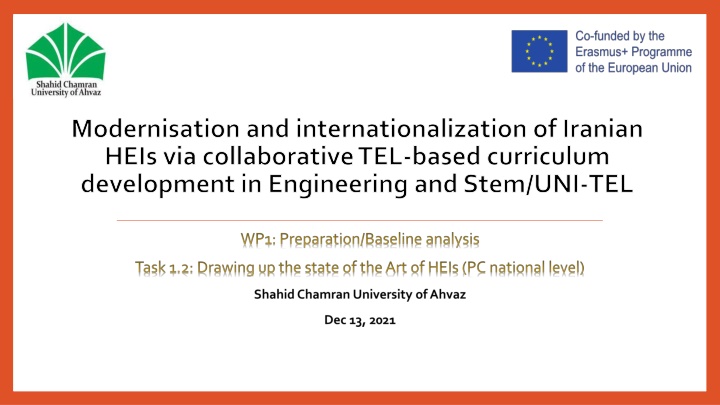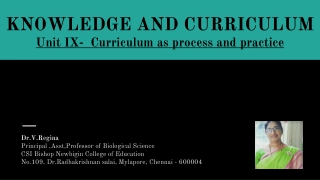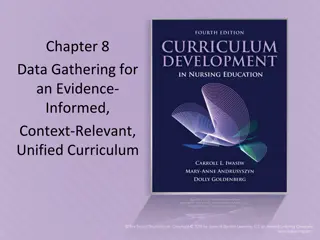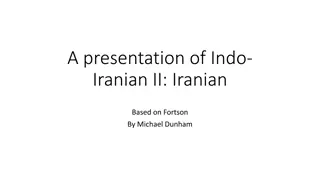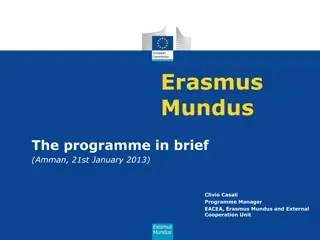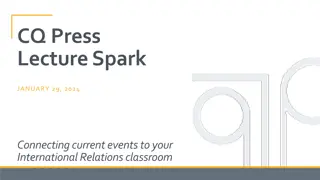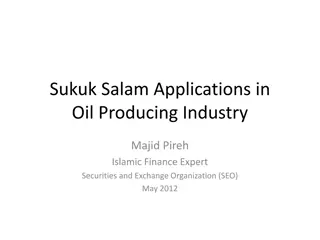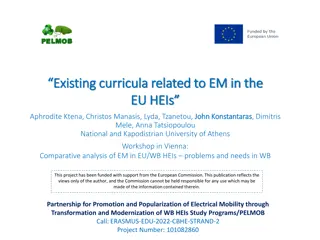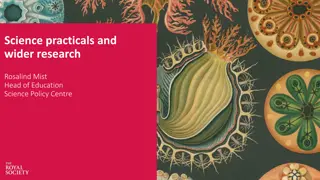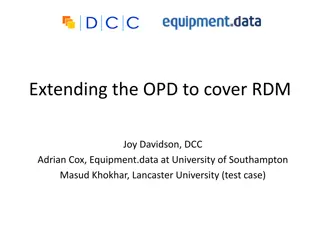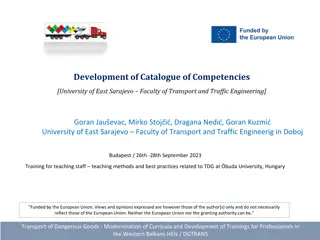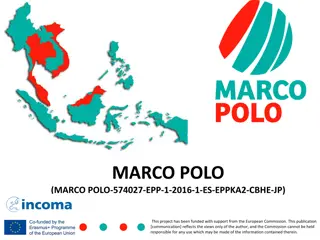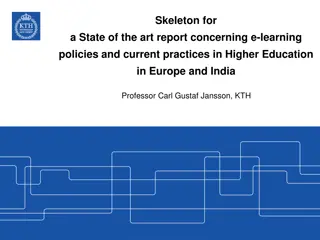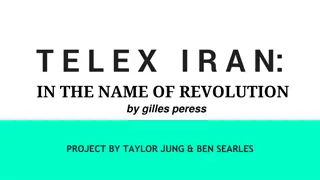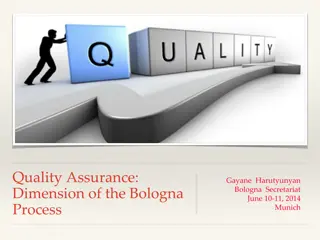Collaborative Curriculum Development in Iranian HEIs
The modernization and internationalization of Iranian Higher Education Institutions through collaborative Technology-Enhanced Learning (TEL) curriculum development in Engineering and STEM fields. Learn about policies, strategies, and practices in curriculum planning, including needs analysis, goal setting, industry relevance, laboratory activities, and the impact of COVID-19 on educational practices. Discover how stakeholders' needs are integrated into curriculum development and how courses are designed to meet business and societal demands.
Download Presentation

Please find below an Image/Link to download the presentation.
The content on the website is provided AS IS for your information and personal use only. It may not be sold, licensed, or shared on other websites without obtaining consent from the author.If you encounter any issues during the download, it is possible that the publisher has removed the file from their server.
You are allowed to download the files provided on this website for personal or commercial use, subject to the condition that they are used lawfully. All files are the property of their respective owners.
The content on the website is provided AS IS for your information and personal use only. It may not be sold, licensed, or shared on other websites without obtaining consent from the author.
E N D
Presentation Transcript
Modernisation and internationalization of Iranian HEIs via collaborative TEL-based curriculum development in Engineering and Stem/UNI-TEL
2.1. Policies and guidelines in use for curriculum planning: 2.1.1. How do you plan the initiation of a course (e.g., needs analysis for demand constraint identification etc.)? Based on need analysis, (labor market needs, national, provincial, city needs, and department facilities) Departments design and suggest a new course to Ministry of Science Research and Technology (MSRT), then MSRT revises if necessary and finally offers to all universities. 2.1.2. What kinds of goals are set in the organizational strategy and other governing documents for overall curriculum planning and development? The goals are mainly set in light of third and fourth university generation, internationalization, entrepreneurship, students' needs and ethics.
2.1.3. Are the needs of working life and the industry somehow described in the governing documents? If they are, please describe, how? No unified and clear answers. 2.1.4. Is TEL/online learning part of the overall strategy for your institution s development and how? Yes, TEL/online learning is part of overall strategy for Improving and expanding university functions. Many universities had e-learning infrastructure before covid-19 pandemic but with the emergence of the Covid Pandemic, e-learning become a main university strategy. 2.1.5. Do you foresee laboratory activities within curriculum planning? Yes, Laboratory activities are always part of STEM programs. These may include engineering sciences (physics, chemistry, etc.) or specialized courses which require labs.
2.1.6. Which kind of laboratory activities do you use (e.g.in presence, virtual, remote labs etc.)? The main laboratory activities are in presence, some universities use virtual labs. Only the university of shiraz reported remote lab. 2.1.7. In case you use virtual/remote labs can you please describe them in terms of technological infrastructure and pedagogical model applied? Using related software and hardware 2.1.8. Has the COV-19 pandemic affected your curriculum planning practices? In which way (Please describe any changes that occurred after covid pandemic broke out)? Covid-19 has affected all instructional and learning activities, indeed all the pedagogical activities become virtual.
2.2. Curriculum planning in practice 2.2.2. How are different stakeholders (e.g. teachers, students, businesses and other actors in society) and their needs taken into account in the curriculum development? Universities offices such as Industry relations and planning and academic supervision are responsible for identifying business and society needs. also, recently faculty members must to spend a 6-month period at business to get familiar with business needs. 2.2.3. How is the content of the course designed? For most courses, the Ministry of Science, Research and Technology (MSRT) lists Courses, Modules, and as well as Syllabuses. However, some flexibilities are acceptable made by academics who are experts in that specific field. But for planning a new module and syllables, the professors of a department provide a proposal and take the procedure described befor.
2.2.4. In faculty level, does the curricula design reflect any specific pedagogical practices and innovation? No relevant answer received. 2.2.5. In faculty level, what way is working-life relevance discussed in the curricula? It is totally dependent on the teacher; although some suggestions are presented in curriculum documents, the teachers are free to use them. 2.2.6. What is the teaching staff-student ratio? 1:21 to 1:28
3.1. TEL as a practice in your institution 3.1.1. Is TEL or online courses a usual practice in your university, or do you organize teaching like this only due to pandemic? Before pandemic TEL or online courses were not widespread, but after that it became prevalent practice. 3.1.2. How many, in what level (e.g. graduate/postgraduate)? UI: 4000 classes each week in all levels. UT: during last autumn semester (2020), 42687 users (32825 students) worked with the platform. 8371 courses were offered online (101321 sessions). SCU: 2021-2022 BA. MA. Ph.D. D.V.S. Sum total Online classes NR NR NR NR 3396 Offline classes 4223 1946 885 392 7446
3.1.3. Is TEL part of the overall strategy for your institutions development and how? Yes, TEL is a part of the university strategy, but clear and relevant details are not reported. 3.1.4. Is there a strategy in your institution for digital innovation, TEL being a part of it? Is this strategy known within the institution at all levels? Yes. All universities reported a strategy.
3.2. Technology in use The technologies used are: Online platforms: According to received data most Iranian universities are using Adobe Connect, Big Blue Button and Skyroom platforms for online and synchronous communications. Adobe Connect & Big Blue Button are popular worldwide but Skyroom is a domestic platform which has been designed and implemented by an Iranian company. This VC also is widely used by K12 schools. Offline platforms: The universities commonly are using Moodle for asynchronous communications and for uploading videos, homework, assignments, creating discussion enlivenments and taking quiz.
3.3. Course development process 3.3.1. How do you plan the initiation of a course (e.g. needs analysis for demand and constraint identification etc.) in TEL/online courses compared to face-to- face courses? There is no difference between online and face-to-face curriculum, however, the faculty members are trained to use the LMS, videoconferencing, and other required software.
3.4. Stakeholders involved and their roles and tasks 3.4.1. Do you involve students in TEL/online course design? Not totally, some universities receive students' feedback and report them to faculty members, and encourage them to use it in course design. 3.4.2. How is the content of the course designed? It is designed the same as face-to-face courses. 3.4.3. Is there any technical support for teachers in course design? Is support given at university, faculty or department level? There is an office or a center that is called Teaching Development Centre or Educational planning office in the universities which hold some workshops and online courses about course design. 3.4.4. Are there any facilitators that support the learners? If there are, please elaborate: describe their role, tasks and the cooperation with the lecturer. No unified and clear answer was received.
3.5. Protocol of course assessment 3.5.1. How do you evaluate the course: Is there a systematic institutional process / protocol? Are students involved at this stage? Although Faculty members are free to select their evaluation methods, there are some standards and regulations which every teacher must take into account. 3.5.2. How is evaluation performed after the course is taught/delivered? Based on university LMS and by different tools the courses are evaluated. 3.5.3. How is data collected? The office educational planning is responsible for collecting and analyzing data. 3.5.4. Do students give feedback on teaching? If, please describe how. By the end of the semester there would be a survey to evaluate the course based on students opinions.
3.5.5. Who is informed about the evaluation? The evaluation results are statistically analyzed by the system. Each faculty member will have access to the results through the designed platform. Here, he/she receives the feedbacks, his/her rank in the department. These data are also available to the head of the department, dean of the college, and the office of vice-president in educational affairs. 3.5.6. What measures can be taken for improvement? No unified and clear answer was received.
3.6. Identification of TEL /online quality practices or patterns of quality 3.6.1. Is your Institution using Quality standards/frameworks for TEL/online? There is a quality assurance system which is not customized for TEL-based learning. 3.6.2. If no, what are the reasons? No respond. 3.6.3. Are you planning to use one in the future? No respond. 3.6.4. If yes, which are they? No unified and clear answer was received.
3.6.5. What quality areas do they cover? How long have you been using them? Technology, Covering the curriculum in the designate time, Quality of online interaction, Quality of the contents and instructional materials, Quality of online teaching and Teaching strategies. 3.6.6. Does your Institution collect data in order to evaluate TEL/online programs? Faculty members are the only source for collecting data. And at the end of semester, they will be informed about the result. 3.6.7. Is there a strategy on the use and purpose of learning analytics within the institution? No unified and clear answer was received. 3.6.8. Does your institution consider ethical norms and government policy with respect to data protection and the privacy of students? Yes, the University is very strict in this regard.
3.7. Process of continuous improving of educational provision 3.7.1. Are TEL/online programs reviewed, updated, and improved and how? TEL-based programs are treated the same as face-to-face programs. Normally Each program is updated every 5 years. 3.7.2. Are there any Institutional policies, structures, processes, and resources in place to guarantee the successful teaching and learning process of students with special educational needs? No unified and clear answer was received.
3.7.3. Is there an institutional policy and code of practice to ensure academic integrity and freedom and ethical behavior? MSRT provides some policies and codes of practice to ensure academic integrity and freedom and ethical behavior. 3.7.4. Are there any electronic security measures set by your institution s policy/code of practice? University's informatics and information center is responsible for electronic security. They may have procedures for this.
3.8. Professional development of teachers and instructional designers 3.8.1. In faculty level, do people involved in designing/ developing/ evaluating TEL/online programs have specific expertise in academic and technical aspects and which? There are some faculty members who have expertise in the design/development/evaluation of online programs. 3.8.2. Is the teaching staff involved in designing/ developing/ evaluating educational programs familiar with the advantages/disadvantages of using TEL/online in particular course contexts? They recently during the covid 19 pandemic got familiar with the advantages/disadvantages of using TEL/online in particular course contexts. 3.8.3. Is the teaching staff trained and proficient in the use of learning technologies and (e-) assessment methods? Training courses are offered by e-learning center in order to help staff make use of electronic facilities.
3.8.4. Are there any particular training activities for new staff? All new incoming staff are invited to meetings for the enhancement of teaching capabilities. 3.8.5. Has the institution developed procedures to identify the support requirements of the teaching staff? There are some centers in the university that are to identify the support requirements of the teaching staff. 3.8.6. What workshops are available for your teachers to attend? (for example: professional development, enhancement of faculty competence in skills, enhancement of faculty competence in pedagogy and enhancement of faculty competence in TEL). Faculty competency skills such as: method of teaching, motivating students, assessment of learning, and so on.
4.1. Policy and action plan for industry- relevance 4.1.1. Are industry needs considered when developing the learning model and the curricula design? Yes, all programs are developed based on industry needs. 4.1.2. How is industry and other stakeholders involved in the process? Are there specific needs considered for STEM education in your institution when transferring courses to technology enhanced learning or online learning? If so, please explain how. When designing, developing, and updating curriculum industrial and social needs must be covered.
4.2. Infrastructure 4.2.1. Is the technical infrastructure aligned with the teaching methodology, learning activities, and e-assessment methods? If so, please explain how. The Iranian universities have attempted to adapt teaching and learning activities with their existing infrastructure, but such platforms are most aligned with theoretical courses. The most LMSs have a plugin for creating assessments. Unfortunately, there has not been an opportunity or a platform for crating authentic evaluation. 4.2.2. Does the mentioned infrastructure and used online tools support student active learning and collaboration? The existing platforms could support active learning and collaboration, but many students due to weak technologies and the internet bandwidth have not enough interaction with their instructors. And also, some LMSs are not enough User-friendly to create active learning environments.
4.3. Assessment of learning 4.3.1. Are (e-) assessment methods fit for purpose, allowing students to demonstrate the extent to which the intended learning outcomes have been achieved? Due to the pandemic the university was forced to quickly move to e- assessment. Accordingly, several workshops were organized about e-assessment programs, designing and implementing e-assessment as well as formative assessment. There is not any formal data about success or failure of e-assessment. 4.3.2. How are they designed? Usually, student learning is assessed on the LMS platform. Different types of questions such as multiple-choice, true-false, easy, and so on have been used.
4.4. Functionalities of the technical infrastructure 4.4.1. Does the virtual learning environment, VLE (if any) support specific pedagogical methods and tools? It seems the existing VLE supports only direct pedagogical methods. For instance, the lecture method has been used frequently by departments. 4.4.2. Is the VLE based on non-proprietary web standards and is it updated to reflect technological changes? How often? The majority of the Iranian Universities use open sources web standards. They customize VLE according to their needs and circumstances. The web standards are frequently updated at the end of the academic year. 4.4.3. Does the technical infrastructure ensure the accessibility of the TEL/online programme by students with special educational needs and how? Not specifically, since the universities have no long background in e-learning such required tools have not been considered.
4.5. Use of virtual and remote laboratories 4.5.1. Does the institution provide students with an e-library? Yes, all universities provide e-library. 4.5.2. Does the institution have virtual labs? According to the received data, only the university of Tehran and Shiraz university have virtual Labs. The rest did not report any such tools. 4.5.3. Does the institution have remote labs? Only Shiraz University has remote labs.
5.1. Staff professionalization 5.1.1. Has your institution procedures for recruiting and hiring teaching staff? Iran ministry of science and technology has regulated some procedures for all universities and also each university has its own for recruiting and hiring teaching staff. In addition to the usual procedures, the university has criteria and requirements for recruiting and hiring teaching staff. Such as specialized knowledge, skills, knowledge and teaching motivation. 5.1.2. Do you offer pedagogical training for teaching staff? Do you have courses specific for technology-enhanced learning? How is it organized? Every year, the University Planning Office or any other center organizes courses for faculty members on teaching methods, lesson plan, test design, and the use of technology in teaching. With the occurrence of the corona pandemic, some training courses were further emphasized and held such as teaching online & offline, interacting with students virtually, using different tools and technologies in teaching, and e-assessing. Usually, the planning office conducts a preliminary needs assessment for each training course and the training objectives of the courses are determined based on the results of the needs assessment.
5.1.3. How is the teaching staff coordinated during course delivery? The university educational planning office schedules training courses and usually courses are presented at the weekend or at the free times. 5.1.4. Do you have support materials available on the intranet for online learning and teaching? Many instructional materials are available on the university LMS, and every teaching staff can reach them. 5.1.5. Is pedagogical training mandatory for teaching staff? Yes, such trainings are mandatory. Training on producing instructional materials, interaction with students, e-assessment, motivating students to learn online and teaching online have been designed, developed and presented.
6. Opportunities and challenges for adoption of TEL practices 6.1. Opportunities: Providing online learning software and training for faculty members. Faculty members can use various type of media in teaching (video, audio, multimedia, simulation and etc.). Reviewing and updating the curriculum regularly based on the needs of society and industry. providing the practical training in form of online for industries. Possibility of reducing educational and laboratory costs by holding theoretical and practical-laboratory classes of educational groups online. Possibility to recruit faculty members of other universities to present e-courses. More flexibility in course scheduling (time, duration, etc.). Facilitating design and development of new interdisciplinary programs.
6.2. Barriers: Poor advanced technological infrastructure. Challenges to teaching practical courses. students' Poor Motivation to participate in online learning activities. E-assessment challenges in particular cheating. Lack of access to high-speed internet in rural areas. Low familiarity of faculty members and students with teaching and learning online. Lower interaction between the faculty member and student.
